This is topic Somikon HD-XL Film Scanner & Digitizer (Super) 8mm - EU market in forum 8mm Forum at 8mm Forum.
To visit this topic, use this URL:
https://8mmforum.film-tech.com/cgi-bin/ubb/ultimatebb.cgi?ubb=get_topic;f=1;t=011449
Posted by Berend De Meyer (Member # 5856) on April 27, 2017, 03:03 AM:
Hi all,
This 1st post for my Wiki-thread is dedicated to the brand new Somikon HD-XL Film Scanner & Digitizer (Super) 8mm - EU
EDIT: as per 04/29/2017 PEARL.DE has a new shipment in stock!
Google Translated Specifications:
HD-XL film scanner for easy digitization of Super 8 and 8 mm films (switchable)
High-resolution 1/3 "CMOS sensor with 3.53 megapixels
Scan resolution: 1440 x 1080 pixels at 30 frames / sec
Stand-alone recording: saves directly to SD (HC) card up to 32 GB, no PC necessary
Recording format: MP4 video, no recording of the audio track
Automatic exposure, manual correction (-2.0 to +2.0 EV), automatic white balance
Light source: LED lighting
Built-in TFT LCD display: 6 cm / 2.4 "
USB 2.0 port for data transfer to the computer
TV output: PAL / NTSC
For Super 8 and Normal 8 film coils (adapter 8/13 mm included) reels up to 17.8 cm / 7"
Automatic stop at the end of the movie
Fast rewinding (requires about 2 minutes for 10 minutes of film)
Integrated carrying handle
Connections: TV-Out (3.5 mm jack), mini USB, slot for SD (HC) cards up to 32 GB, power supply
Supports Windows XP / Vista / 7/8 / 8.1 / 10, OS X from 10.7.3
Power supply: 12 V via 230 V power supply (cable length: 1.2 m)
Measurements: 32 x 18,5 x 11 cm, weight: 1,5 kg
Filmcanner including Film-Leerspule, Film-coil-adapters, spacer-rings for the film guide, power supply, video cable (3.5 mm jack to RCA, 150 cm), USB cable (mini USB to USB, 100 cm) and German instructions.
Hopefully my deck arrives next week, so I can start sharing my review(s) and first test footage here. I'll post all in this first post, so all info's and test results are easy accessible for everybody.
Stay tuned! ![[Cool]](cool.gif)
[ April 30, 2017, 09:07 AM: Message edited by: Berend De Meyer ]
Posted by James Wilson (Member # 4620) on April 27, 2017, 07:10 AM:
Hi Bernard,
Looking forward to your test results,
Regards,
James.
Posted by Berend De Meyer (Member # 5856) on April 30, 2017, 05:03 AM:
I just received an update for the delivery - were out of stock - of my deck. Very excited to finally test-drive it next week! ![[Cool]](cool.gif)
Cheers
Posted by Berend De Meyer (Member # 5856) on May 11, 2017, 12:32 AM:
Hi all,
I received my scanner. I did a quick OOTB scan of the oldest film reels in my collection, the wedding of my parents* in 1957, some 60! years ago. Although still not utilized the scanner to its full potentional, I must admit that I'm very pleased with this first result. As many stated elsewhere, I'm now convinced this scanner is the best bang for the (400) euro I spend on it. It may not come close to a scanner in the $4000 range, but this is way better then to let all those memories disolve into dust and - my ultimate personal goal - preserve it for all future generations to come!
I transcoded the RAW mp4 to mov for import into Final Cut Pro. I then adjusted the speed setting it to 53% (18fps(filmcamera)/30fps)(scanner output) in FCP. I used Denoiser and Magic Bullet Looks for grading and light bloom.
Here's my first result: https://youtu.be/XRD-89ZlDhE
I'm still tweaking to get the best HD output, but this test is just for reviewing the OOTB capabilities of my new scanner!
Keep you posted on any progress for this huge project - 24x 18cm / 7" reels! I'm very glad that it can receive my 18cm / 120 meter reels, so I don't have to slice them and rewind them back to smaller size reels. ;-)
Thanks for watching, I hope you'll like the result so far and of course directions/tips for an even better output is greatly appreciated!
Cheers
Posted by James Wilson (Member # 4620) on May 11, 2017, 06:21 AM:
Hi Bernend,
Thanks for the sample of film, it looks really good to` me.
Please can you tell me how long it took to render the speed.
Many Thanks,
James.
Posted by Berend De Meyer (Member # 5856) on May 11, 2017, 09:12 AM:
Hi James,
Thanks for your reply, glad you liked it! ![[Cool]](cool.gif)
Rendering the speed goes along with the other render depending tweaks. When I import the to .MOV converted footage, I can adjust the speed "on the fly" without having to render the speed change to view it. I hope this answers your question?
Cheers
Posted by James Wilson (Member # 4620) on May 11, 2017, 09:57 AM:
Hi Berend,
That's quicker than I expected,
Thanks for the answer,
Good luck,
Rergards,
James.
Posted by Gary Sayers (Member # 5545) on May 11, 2017, 10:53 AM:
Hi Berend,
The footage looks very good. In fact, it's the best quality I've seen on youtube for examples of this particular scanner.
On the youtube settings, it will only allow a display at 360p. Was it scanned at 1080p but uploaded at a lower (but clearly still impressive) quality?
Also, is it possible you could upload the same footage 'as scanned' before you did any tweeks to the quality and speed?
Thanks,
Gary
Posted by Berend De Meyer (Member # 5856) on May 12, 2017, 03:42 AM:
Hi guys,
Thanks for watching and glad you like the footage so far! I must admit that this footage is the best reel in the entire collection 1956-1968! It was filmed by a pro camera man/woman.
As said earlier I'm still tweaking the HD output, Youtube seems to crack the contrast in my footage. I'll upload the raw .mp4 - without any adjustments - as well. Besides that I'm going to import this footage in my Windows 10 based Power Director Suit 15 and check if the conversion can be done even better. I'm not sure my workflow in macOS Final Cut Pro 9 is correct. So stay tuned!
Keep you all posted on my next testrun in PDv15
Posted by Berend De Meyer (Member # 5856) on May 13, 2017, 10:12 AM:
Hi Gary,
I managed to upload the RAW .mp4 - only imported & exported to MP4 H264 in PDv15 to get the 1440x1080p output - to Youtube!
https://youtu.be/zvmB0e-hlVU
EDIT: you may notice that I zoomed out on the scanner before capturing showing the film edges and transport holes. The reason why is simple. In my editing software I then crop the footage to the maximum viewable area, giving me the oppertunity to maximize the field of view for editing the eventual frame crop and using the advanced image stabilzing feature of Power Director v15! ![[Cool]](cool.gif)
Tomorrow I'll be able to show you the new output (HD 1080p) video from PDv15.
Cheers
[ May 13, 2017, 11:35 AM: Message edited by: Berend De Meyer ]
Posted by Gary Sayers (Member # 5545) on May 13, 2017, 12:07 PM:
Hi Berend,
Thanks for the new upload. It's very interesting to see the raw footage that you obtained from the scanner.
I've had a Wolverine on order for a few weeks now but I'm in two minds about swapping for the Somikon.
I'm confused with Wolverine saying that they went for 720p because at 1080p there was an issue with picture quality.
I don't see an issue with your raw footage beyond a very slight grain (which can be also seen on various Wolverine 720p uploads on youtube).
Look forward to your next upload.
Thanks,
Gary
Posted by Berend De Meyer (Member # 5856) on May 13, 2017, 03:04 PM:
Hi Gary,
Thanks for watching and of course you're most welcome!
I can't really speak for the Wolverine, simply because I never tested that deck. But for what I've seen on Youtube (720p) if I would be you, I'd reconsider and grab the Somikon. Although I'm NOT excited at all about the build-Q - to put it mildly - this deck has a very decent output for it's price. The engineers did a very lousy job on the outer specs of this scanner. The reels are very wobbly connected, resulting is scratching sounds from the film touching the reels.
For now I can live with it, doing a 24x 18cm reel job to secure our archive.
I'll upload the finished HD-1080p output asap!
Cheers
Posted by Gary Sayers (Member # 5545) on May 14, 2017, 10:53 AM:
My Wolverine order actually shipped today so I am going to give that one a go, although I probably should have gone with the Somikon as you say Berend.
My thoughts are really to try and get a reasonable, flicker free, transfer of my home movies at a low cost,then wait until there is a better low cost device on the market.
I will probably sell the Wolverine when I have finished as I can't see me ever shooting 8mm again (shot both 8mm & S8mm regularly from 1975 to 2000) at the current high price of stock and processing.
Posted by Berend De Meyer (Member # 5856) on May 14, 2017, 01:33 PM:
Hi Gary,
Sure you can test the Wolverine, if oke scan all your home movies and sell it afterwards, a rather good idea.
Looking forward to your review and converted footage.
Cheers
Posted by Berend De Meyer (Member # 5856) on May 21, 2017, 04:20 AM:
Hi all,
This issue might become the biggest dealbreaker for the upgraded Somikon.
https://youtu.be/8lUuh-BPnLY
The jumping of the film results in a scrambled image on the bottom of the RAW that can't be adjusted in post production editing software.
https://youtu.be/a8gHhvMoY8Y
Will return this unit asap for an new unit, I might just got a bad one....!
Cheers
Posted by Gary Sayers (Member # 5545) on May 21, 2017, 12:07 PM:
Hi Berend,
I decided to return my Wolverine, unused, to Amazon.
After looking at so many examples on youtube, I came to the conclusion that it was just not for me, even for it's relatively cheap price.
Like many on this forum, I had already tried doing transfers using a video camera pointing directly at a projected image. The results were not bad but the flicker was quite noticeable.
I've been experimenting recently with a cheap compact camera that also shoots video. Using it's full auto function, recordings begin very flickery but once it has decided on a suitable shutter speed after a few seconds, it settles down and the results are very good.
I just need to do some fiddly work with the camera to find the manual setting for the right shutter speed (there is no actual shutter speed setting, just loads of icons for 'sports', 'night time', etc). Not had the time to try to sort this yet.
So I decided that I would rather do transfers this way and not have to worry about all the messing with a computer afterwards.
Gary
Posted by Janice Glesser (Member # 2758) on May 21, 2017, 02:54 PM:
Gary what projector are you using? If it doesn't have variable speed adjustment it's next to impossible to get flicker-free captures with just camera settings.
Posted by Gary Sayers (Member # 5545) on May 21, 2017, 03:23 PM:
Hi Janice,
I used my 42 year old Eumig Mark S 810D projector and a Nikon Coolpix L30 compact camera.
As you rightly say, without a variable speed control on the projector, getting a flicker free picture is near impossible and believe me I've tried over the years!
But using this set up it did look very good (the best I've ever obtained, anyway - in terms of flicker). I was only messing with all the different cameras and phones in our house one afternoon and I've not done a proper transfer yet.
I'm currently sorting out a room to have a permanent set-up for some major archiving of film, photos and video. I'll try and do a test in the next few days and upload it to youtube.
Gary
Posted by Paul Adsett (Member # 25) on May 21, 2017, 03:42 PM:
I use a Bolex 18-5 for video transfer. This is a fixed 18fps projector and the flicker is very noticeable - until I slow the shutter speed on my Sony camcorder, when the flicker is all but gone.
Posted by Barbara Strohl (Member # 5227) on May 24, 2017, 12:19 PM:
My Wolverine broke after a bunch (40 some) of 3inch reels.
Something broke with the uptake tensioner. I didn't open it up because I am sending it back.
My decision was because I haven't had it long, I bought it direct, and postage to CA isn't much.
When I spoke to them they were keen to get my machine back because they haven't had this issue before and I got one of the first of the newest batch.
It will still run and rewind as long as it doesn't need to wind the film while recording.
I didn't have a lot of the problems that people had reported before. I would not leave this running unattended for long because it would get stuck but not that it damaged the film.
My unit didn't get hot. It does have the new vents, I kept it where it gets good air flow, and I like my work room at 65F or less.
I used compressed air to clean it off if it hadn't just been running.
I cleaned every film before running. I found I had dropped frames if the film wasn't completely dry so most sat over night before running.
Most films seem to run better backwards.
It really doesn't like any bending in the films. Ironing helped.
Splices seemed to be hit or miss. Tape vs cement didn't matter. I thought I would figure out what was an issue and then something would ruin my theory.
I doubt that it mattered but I did run it in low light or the dark. This wasn't hard with other stuff I'm doing.
My biggest problem is myself. I am not willing to sacrifice ANY frames. I will not cut out damaged sections or bad cement splices. Most of the films have shrinkage, warping, bends, tears, and everything else that you can imagine. Most of these I won't let near a projector ever again. The ones in the best shape, or sometimes part of a film, I was willing to try but even that was a strain.
If you have films in good enough shape to project this should work for you.
Posted by Berend De Meyer (Member # 5856) on May 25, 2017, 03:37 AM:
Hi Barb,
Thanks a lot for your review, appreciated. I really love the concept of the Wolverine and the Somikon film scanning decks, but I'm very disappointed about some of the poor engineering and execution:
1. Why not reels up to 180 meter, the distance between the two reels is only 1 cm short, as I can't imagine that the extra weight (+60mtr) will have a very negative outcome for the rotating motor used.
2. Very poor and wobbly mounting points for both reels, causing the reels to scratch the front plate
3. Higher resolution (MP) sensor for 1080p for even better RAW output quality, to have a better starting point when beginning the post-process.
4. Why is the scanning frame not pulling the film more downwards, to prevent the film jumping in the scanning area
As reported I'll exchange mine for a new one. Perhaps I was unlucky with the one I got.
Cheers
Posted by James Wilson (Member # 4620) on May 25, 2017, 06:36 AM:
Hi All,
Why can't these companys test these products thoroughly instead of leaving the job to us? They must have known about the short comings. Now you've pointed them out for them lets see if they fix them!
Regards,
James.
Posted by Andrew Woodcock (Member # 3260) on May 25, 2017, 07:10 AM:
Probably not. It's all to a price and as with anything else in life, you pays your money, you take your choices.
Even very badly designed items can sell in huge quantities so long as they are cheap enough. People are just desperate to just get something that will do a particular job, whether that's a power tool whose motor won't last 12 months, a fridge that can set on fire or in this particular case a scanner that seemingly comes with huge compromises.
[ May 25, 2017, 09:05 AM: Message edited by: Andrew Woodcock ]
Posted by James Wilson (Member # 4620) on May 25, 2017, 08:19 AM:
Well Andrew,
if thats the general opinion I think they will keep turning out inferior goods.
Posted by Andrew Woodcock (Member # 3260) on May 25, 2017, 09:13 AM:
Sadly it is a fact now in this modern day era so far as consumer goods are concerned over all.
Price over Quality sadly,..otherwise everyone doing this activity would be buying a Tobin machine.

Posted by Barbara Strohl (Member # 5227) on May 25, 2017, 10:53 AM:
I think the main point that must be kept in mind is that this is being designed and marketed to home users with home/family films.
First off, the average person will only have 3" reels. Maybe a few 5". 7" reels for home movies are very rare.
Secondly, the quality of most of these movies are poor. Lenses were dirty, lighting was bad, kids fought over the camera, someone who new nothing would get stuck holding it,it got turned on and off at the wrong times, film ran out in the middle of things. Yet we still managed to capture memories.
Finally they do need to keep it cheap. Probably by making sacrifices. These are going out to people who don't have the funds to buy a better machine or send 50 reels to a service. Those options have been around but average people can't justify the cost.
My complaint is that the final MP4s are the wrong speed. I realize that they have tried to make this simple eough for anyone and they have come close.
A non-tech friend on a tight budget was thrilled with the film after I reset the FPS. If the FPS was right, she could borrow my machine and do her own films. If her husband found a job, they could get their own machine.
I still think there is a place for machines like this but it isn't for everyone. Decide your own needs.
Posted by Doug Stratton (Member # 5923) on May 25, 2017, 09:57 PM:
Hey Barbara,
you might want to read my post on page 3 here. Its really easy to fix the framerate on these scanner clips with no re-encoding (no quality loss) and takes less than 20 seconds
http://8mmforum.film-tech.com/cgi-bin/ubb/ultimatebb.cgi?ubb=get_topic;f=1;t=011395;p=3
Posted by Ty Reynolds (Member # 5117) on May 26, 2017, 02:46 AM:
It has been stated a few times on this forum that 50-foot reels are the norm for home movies, some were on 200-foot reels, and that home movies on 400-foot reels are rare.
Not so. I've been doing film conversions for more than 25 years, and still digitize several thousand feet a week. More than half my customers bring in at least some of their films on the 7-inch reels.
If 400-foot reels of film were so unusual, the market for projectors with that capacity would be very small. As it is, projectors limited to 200 feet are the scarcity.
This is why the Wolverine's 200-foot limit seems like a shot in the foot to me.
Posted by Barbara Strohl (Member # 5227) on May 26, 2017, 10:07 AM:
Thanks Doug. I'll look at that.
Posted by Berend De Meyer (Member # 5856) on June 26, 2017, 01:21 AM:
Returned my deck for an exchange! Keep you posted.
Cheers
Posted by Berend De Meyer (Member # 5856) on July 02, 2017, 07:29 AM:
Hi all,
UPDATE: my deck is being investigated bt PEARL.DE atm. Keep you posted!
Cheers
Posted by Berend De Meyer (Member # 5856) on July 09, 2017, 10:46 AM:
Hi all,
Received a brand new scanner for an exchange! Great service by PEARL.de. Getting ready for a new batch of 8mm scanning. Keep you posted about my findings. I do hope I had a Blue Monday scanner last time and that this one will be better and last longer.
Have a nice Sunday! ![[Cool]](cool.gif)
Cheers
Posted by James Wilson (Member # 4620) on July 09, 2017, 01:48 PM:
Hi Berend,
I hope you have good fortune with this one, can you see any upgrades eg, vents in back, internal fan, upgrade on the belt drive,
Many Thanks,
James.
Posted by Berend De Meyer (Member # 5856) on July 10, 2017, 07:51 AM:
Hi James,
The deck is the same as the previous one, so doing another batch will prove if any improvements were made.
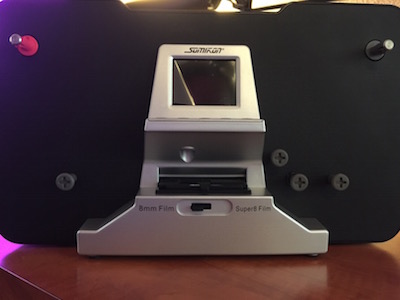

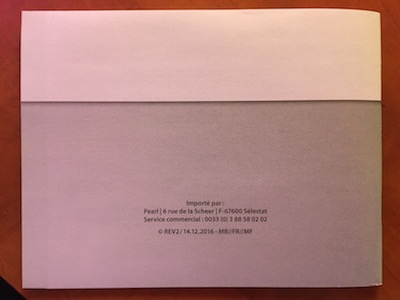
Cheers
Posted by James Wilson (Member # 4620) on July 10, 2017, 12:29 PM:
Hi Berend,
Thanks for the pictures, are the vent slots in the back original?
Regards,
James.
Posted by Berend De Meyer (Member # 5856) on July 11, 2017, 06:01 AM:
Hi James,
You're most welcome! Yes, the vent holes on the back are original as per this rebranded deck. The Somikon is like a v2 version of the Wolverine.
- higher resolution
- better thermal engineering
I did not open the deck - voids warranty? - to see the internals. But, if you have a choice I would recommend the Somikon for sure!
Cheers
Posted by James Wilson (Member # 4620) on July 11, 2017, 07:17 AM:
Hi Berend,
Thanks that`s just what I was hoping to hear.
Regards,
James.
Posted by Berend De Meyer (Member # 5856) on July 16, 2017, 08:01 AM:
Hi James,
Have you decided yet? Just curious.
Cheers
Posted by James Wilson (Member # 4620) on July 16, 2017, 10:22 AM:
Hi Berend,
Yes, I will go with the Somikon, even if it`s only for the 7" reel transfer capabilities.
Regards,
James.
Posted by Berend De Meyer (Member # 5856) on July 16, 2017, 10:48 AM:
Hi James,
Good luck with your purchase and let me know what your experience is with it. Most reels I receive are indeed 7" or smaller.
Cheers
Posted by Peter Scott (Member # 4541) on July 17, 2017, 06:07 AM:
Hello Bernard
what web site can you order this from and do you know if they will ship to the UK as I would so much like to get one, its far better than the Wolverine
Posted by Roy Woodward (Member # 5994) on July 21, 2017, 02:48 AM:
Hi Peter Scott. I'm another person interested in this type of product in the UK.
My father passed away earlier this year, and he was an avid cine enthusiast in his younger days. So I have dozens of reels of 8mm and Super 8 I'd like to digitise.
Here in the UK we are in the unfortunate position where no UK supplier seems to sell these products. The Wolverine is only available in the USA. There is an identical machine (from the original Chinese manufacturer I think) called a Winait which is for sale at UK£299.99, but from the delivery info will be shipped from China, and therefore subject to import duties.
My preference would be for the Somikon HD XL, with the 1080p scanning, 400ft capacity, and later design. In Europe this seems to be sold exclusively by Pearl, in France and Germany. I've contacted Pearl.de, and they have confirmed they will export to the UK. There the scanner is Ä399.99, and Pearl have confirmed a shipping cost of Ä19.99 to the UK. This total converts to about UK£365, so probably not much more expensive than the Winait.
I hope that info is of some help. Finally, has anyone else taken the plunge and had experience with the Somikon, and how is Berend's replacement unit performing?
Posted by Peter Scott (Member # 4541) on July 21, 2017, 03:32 AM:
Hello Roy
I managed to get one from Ebay Germany (brand new) and the cost with shipping to UK was £318.
I have a wolverine but not very impressed matter of fact its the second one as the first packed up and I had to send it back to wolverine in California only for me having to pay the carriage and duty again to get a replacement.
My reason to get a Somikon is the 400ft capacity.
Posted by Berend De Meyer (Member # 5856) on July 21, 2017, 06:13 AM:
Hi Peter,
Sorry for my late reply. I ordered mine at www.PEARL.DE
Roy, thanks for all your additional info's! I haven't been able to start a new batch yet, will keep you all posted of course.
Cheers
[ July 24, 2017, 04:02 AM: Message edited by: Berend De Meyer ]
Posted by Mike Spice (Member # 5957) on July 21, 2017, 06:35 AM:
I can confirm that doug stratton software for frame rate conversion is easy and fast.
The presets don't offer 18fps but it is easy to edit the frame rate to any value you like.
Info from Kurt who kindly posted this for me.
You can actually choose ANY frame rate you wish if you do this little change in My MP4Box:
Under "View", choose "Edit Command Line".
When you start Mux, you can choose Fps=15, you will see a new window with the actual command line which you can edit where you see the fps=15 you just change the numbers from 15 to 18 (or 24 or whatever), then press "Copy and Run".
Hope this helps
Kurt
Posted by Roy Woodward (Member # 5994) on July 21, 2017, 06:49 AM:
Hi Peter,
Thanks for the update. I've looked today on eBay.de, but there are only two listings from Pearl (for new or refurbished units) and an auction for a used one. Is the seller who sold yours still listing? I only ask because it seems cheaper than importing a unit from Pearl.
Hi Berend,
I'm looking forward to any further updates once you get chance to use your new unit. The trouble is we all lead such busy lives!
Thanks and regards,
Roy
Posted by Peter Scott (Member # 4541) on July 27, 2017, 07:17 AM:
Sorry for the delay in getting back, I have just received my Somikon and first thoughts are its far superior than the Wolverine, the capacity to transfer 400ft reels is a big bonus plus as well in high def.
Getting the Wolverine you have to remember the added fees (VAT, Import Duty, Handling) this all adds up and increases the price, plus the quality is not soo good, my first Wolverine packed up, it cost me money to send it back to Wolverine then they said it was my fault and would not replace it, so I had to buy a new one from them, admitted they reduced the price but then again I had to pay the fees to get the replacement into the UK.
I would definite go for the Somikon rather than the Wolverine
Posted by Berend De Meyer (Member # 5856) on July 27, 2017, 08:08 AM:
Hi Peter,
Congrats with the purchase of your Somikon. A wise choice over the Wolverine and I hope you'll enjoy it - results for the euro - as much as I do.
Today I finally started a new batch of our family archive with my new (exchanged) deck. Just for the record or for others to compare, I got one with firmware # 20170207-PL05-DE. Keep you posted on the results for this new batch.
To adjust the 30 fps speed, I adjust the captures by factor 0.6 in my Power Director Suite, to meet the exact 18 fps my Father shot the footage with his Bell & Howell "Optronic Eye" - Duolex S Vintage Film Camera.
Cheers
[ April 12, 2018, 05:41 AM: Message edited by: Berend De Meyer ]
Posted by Peter Scott (Member # 4541) on July 27, 2017, 10:38 AM:
I have just finished capturing a 400ft reel of standard 8 film but I have noticed that the frame is out in other words at the top of the picture I can see just a small view (not a lot admitted) of the bottom of the other frame is their any adjustment for this or did I thread it up wrong.#
Thanks
Posted by Peter Scott (Member # 4541) on July 27, 2017, 10:39 AM:
I have just finished capturing a 400ft reel of standard 8 film but I have noticed that the frame is out in other words at the top of the picture I can see just a small view (not a lot admitted) of the bottom of the other frame is their any adjustment for this or did I thread it up wrong.
Thanks
Posted by Berend De Meyer (Member # 5856) on July 27, 2017, 10:46 AM:
Hi Peter,
Menu > use arrows left and right to scroll the menu > Frame ADJ > OK >
Best is to adjust the W - zoom out - first to check the center of the frame is ok, then adjust - zoom in - the frame back to the desired zoom factor.
Please note that when you want to capture to maximum size of the frame you need to zoom out and crop the maximum frame in post processing.
X = move the frame up or down
Y = move frame to the left or right
W = zoom in and out
Cheers
Posted by Peter Scott (Member # 4541) on July 27, 2017, 10:59 AM:
Thanks for that Berend
Can you adjust it while the scanning is in progress
Posted by Peter Scott (Member # 4541) on July 27, 2017, 10:59 AM:
Thanks for that Berend
Can you adjust it while the scanning is in progress
Posted by Berend De Meyer (Member # 5856) on July 27, 2017, 11:07 AM:
No you can't. Only when using the Frame ADJ menu option. So check when you have a big reel containing several smaller reels. The may have a different center point.
Advice: take some time to test with your smallest reel (3-5 min) to get accustomed to the menu and settings like exposure and sharpness.
Good luck and have FUN! ![[Cool]](cool.gif)
Cheers
Posted by Berend De Meyer (Member # 5856) on July 27, 2017, 07:48 PM:
Hi Peter,
Sorry to bother you again...
I forgot to mention that I use the OOTB 3.5 jack > composite video cable to output the video output signal - scanning / menu scrolling / adjusting scanning parameters / playback - to a 24" computer HP LP2475 Color Edge monitor.
This will give you a much better take on how the film is scanned frame wise (zoom factor) and you'll have a much better and accurate monitoring for the sharpness en exposure. I found the onboard LCD screen not to be very accurate, because of its odd viewing angle. Please give that a try too, for an overall better user experience while using the Somikon.
Please note that it will also show the big flaw in the compression to MP4 department as in WYSIWYG.
Cheers
Posted by Peter Scott (Member # 4541) on July 28, 2017, 07:50 AM:
Thanks Berend I will use that connection.
I have looked on the menu for frame adjustment but its in German could you give me some idea as to what word I am looking for to adjust frame, or does Somikon do a software update that puts the language of the machine in English.
Thanks
[ July 28, 2017, 09:08 AM: Message edited by: Peter Scott ]
Posted by Berend De Meyer (Member # 5856) on July 29, 2017, 08:45 AM:
Hi Peter,
It already has all major languages in firmware 20170207-PL05-DE
On/Off > Menu > Sprache > English = you're set to go! ![[Cool]](cool.gif)
Cheers
Posted by Peter Scott (Member # 4541) on August 02, 2017, 11:00 AM:
Hello Berend
Could you help us, I am getting aloing fine with my Somikon but I do have a snagging problem, the film is very jumpy after transfer its not smooth viewing if you know what I mean, any ideas please
Posted by Berend De Meyer (Member # 5856) on August 02, 2017, 04:35 PM:
Hi Peter,
Great to hear you've got the menu in ENG now, and managed to get along with your scanner, But, I cross my fingers it isn't like this...
Jumping Jack Flash! ;-(
As stated yesterday, my 2nd Somikon is failing on me again already. The right axle is barely turning when at the end of the 7" reel. My new deck also suffers from the JJF illness again.
Tomorrow I hope to finish my detailed e-mail for both Pearl and Somikon. Keep ya all posted!
Cheers
Posted by Peter Scott (Member # 4541) on August 03, 2017, 02:45 AM:
Hello Berend
Yes my picture is exactly like your Jumping Jack Flash is please let me know the outcome of your email to somikon
Thanks
Peter
Posted by Berend De Meyer (Member # 5856) on August 03, 2017, 09:15 AM:
Hi Peter,
I just found out that Somikon is a re-branding name of the website pearl.de for all goodies "Made in China". I did not see any information about any product "Made in Germany"!
Just filed for an exchange, but also asked them for some more feedback about our issues with the Somikon. Keep you posted of course.
Cheers
BTW: May the best team win tonight in the Euro 2017 match #NEDENG tonight! HUP HOLLAND! ![[Big Grin]](biggrin.gif)
Posted by Peter Scott (Member # 4541) on August 03, 2017, 10:17 AM:
Hello Berend
I think its to do with the take up arm motor assy, this seems to be a problem with the Wolverine unit as well.
Im going to sit on the fence as to the Euro 2017 match but good luck to both sides
Posted by Berend De Meyer (Member # 5856) on August 03, 2017, 10:43 AM:
Hi Peter,
Yes, and I believe that the JJF issue is also caused by that, because the film is not taken up in the speed its needs to be. Resulting the film having no free space to move and bulging up and down in the scan area. To be continued.
[ August 03, 2017, 08:36 PM: Message edited by: Berend De Meyer ]
Posted by Berend De Meyer (Member # 5856) on August 04, 2017, 10:40 AM:
Just received an e-mail from Somikon a.k.a. Pearl for my second exchange. Despite the info I shared, I got no feedback on any of the possible (now known) issues...
Posted by James Wilson (Member # 4620) on August 04, 2017, 11:03 AM:
Hi Berend,
Why don`t they put you in touch with the manufacturer,so you can explain what is going wrong, I`m still holding fire till they get yours sorted,
Regardfs,
James.
Posted by Berend De Meyer (Member # 5856) on August 04, 2017, 11:22 AM:
Hi James,
The e-mailadress I found on the Somikon website is the same for the Pearl website. I wish I could talk/mail to a tech-savy person at the manufacturers end of this tail too.
Pearl and Somikon are what we call "box-shifters" in The Netherlands. It's indeed a pitty that they don't have any technical support here in the EU. The few users I know so far could provide them with so much detailed information for some serious re-engineering and changing the form factor for the most critical parts used for this machine. But hey, it will cost us some serious $ getting a new Somikon 3.0.
User @Mike got a new motor for his Wolverine. I don't think Somikon will do so too and I'm glad about that. They'll just keep exchanging I hope!
Posted by James Wilson (Member # 4620) on August 05, 2017, 10:48 AM:
Hi Berend,
Apparantly, Made in China (most likely by Winaid in Guangdong, China) I hope this helps.
Regards,
James.
Posted by Berend De Meyer (Member # 5856) on August 05, 2017, 10:57 AM:
Thanks James, google took me to the Somikon HD-XL wiki page!
Posted by Peter Scott (Member # 4541) on August 07, 2017, 02:46 AM:
Hi Berend
It seems the Wolverine and Somikon are made by Winaid in Guangdong, China, im going to see if I can get any contact details of Winaid
Posted by Berend De Meyer (Member # 5856) on August 07, 2017, 03:50 AM:
Hi Peter, that would be great! Our new member @Pere is trying to tweak the firmware for the NOVATEK video chip. I do hope we could get in touch with Winaid and encourage the developers to make some really much needed changes to the firmware of both brands of the scanner.
Thanks for your work!
Posted by Peter Scott (Member # 4541) on August 07, 2017, 07:28 AM:
Hello Berend
The Wolverine & Somikon are both made by a company called Winait Technologies here is their web site details http://www.winait.com/
if you scroll down to the bottom you will find contact details, I have just asked about the take up motor assembly.
Peter
Posted by Berend De Meyer (Member # 5856) on August 09, 2017, 02:56 PM:
Hi Peter,
Thanks for that. I just troubleshooted the JJF-syndrome of our Somikon. It seems that the gate-hatch (when closed) doesn't have enough downforce anymore - after using several reels - to hold down the film in the scanning area. To the inside of the hatch there is a little two sided rail fixed with two screws.

1. Flexible rail on the upper side - you can press it upwards
2. Fixed rail on the lower side
When closed:
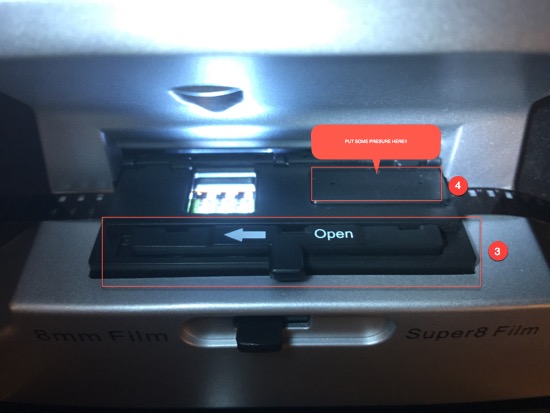
3. The item to open the gate-hatch seems to get loose after opening/closing it over time (very little so it seems in my case), giving the film not enough downwards force to keep the film 100% flat while it goes through the scanning area of the gate.
4. When I put just a little pressure for more downforce in area 4, the JJF-effect is gone!
I needed to check this first before sending it back so I can send my feedback to Somikon per e-mail too.
Posted by Peter Scott (Member # 4541) on August 10, 2017, 04:43 AM:
Thanks Berend I will give that a go, Winait is sending me another take up motor foc, I will fit that and see what happens
Peter
Posted by James Wilson (Member # 4620) on August 10, 2017, 06:32 AM:
Hi All,
Thanks for keeping up the good work, I`m very interested in the outcome.
Posted by Berend De Meyer (Member # 5856) on August 10, 2017, 09:50 AM:
Hi all,
Adding another item on my [b]need-to-have list[/] for my email with my feedback to Somikon/Pearl. They should add the gliders 2 & 3 on the left side so the inlet for the gate has a slight pull force by the extra 2 gliders. This will keep the film much more horizontal without the JJF issue.
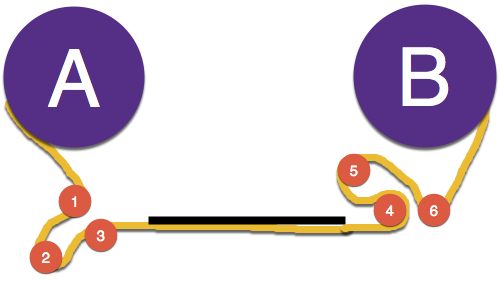
Does this make any sense regarding the technical side of the art of projectors?
Posted by Berend De Meyer (Member # 5856) on August 17, 2017, 07:08 AM:
TIPS while using the Somikon (or what ever brand)!
1. When using the Frame Adjustment option, to calibrate the scan frame format, it is best to attach your deck - using TV OUT - to an external monitor/TV. I've noticed the build-in LCD screen is not 100% perfect calibrated for the output of the scan area. This will result in a frame offset, that will ruin your scans for the best possible import in your post-production video editing application.
2. For the safety of my scanned mp4's, I copy them after each reel is finished. To secure that my SD card is functioning properly - I use a 4GB one - I reformat the SD after each reel. Another pro is that the mp4's will be renumbered again from 0000.mp4 making the file management much easier.
That's all folks, for now!
Posted by James Wilson (Member # 4620) on August 17, 2017, 10:17 AM:
Hi Berend,
Does this mean everything is working properly now,
& are you happy with the Somikon?
Regards,
James.
Posted by Peter Scott (Member # 4541) on August 17, 2017, 10:22 AM:
Hello Berend
Putting extra weight on the gate has it cured the jumping jack flash syndrome?
Peter
Posted by Berend De Meyer (Member # 5856) on August 17, 2017, 10:25 AM:
@James I still have to retrun my deck.
@Peter The extra gentle push force downwards on the spot in my photo does help reducing the JJF syndrome.
Posted by Berend De Meyer (Member # 5856) on August 18, 2017, 08:31 AM:
Working hard to find the best possible post-processing workflow for the scans I've made so far. Here's a capture of my mother from my parents wedding day on 07/14/1957. Starting all over again in a new workflow.
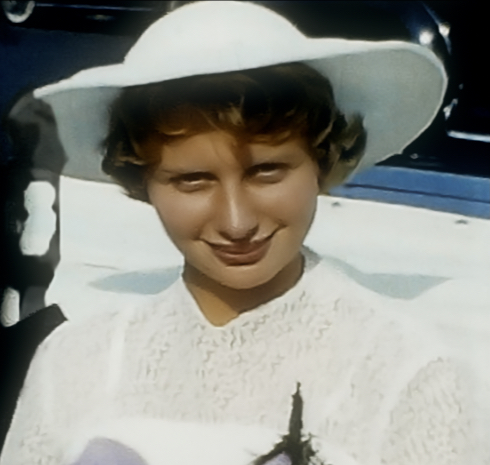
(Added plug-in for FCPX: Neat Video v4) highly recommended!
Man-o-man, what a very lucky guy my dad was! ![[Wink]](wink.gif)
Posted by Berend De Meyer (Member # 5856) on August 24, 2017, 09:02 AM:
* created a new thread *
Posted by Berend De Meyer (Member # 5856) on September 08, 2017, 08:05 AM:
UPDATE! I received my third Somikon HD-XL yesterday. Time for some new testing sequences then this weekend...
Keep you all posted on the 'new' results. ![[Confused]](confused.gif)
Posted by Mike Spice (Member # 5957) on September 08, 2017, 09:12 AM:
With my wolverine scanner I was advised to unscrew one quarter turn on the silver screws in the underside of the gate to help with Jitter problems.
I have been unable to test this yet, as my scanner is awaiting new parts. (again)
Posted by Berend De Meyer (Member # 5856) on September 10, 2017, 03:36 PM:
Thanks for the heads up Mike, haven't had the time yet to unbox my new deck.
Posted by Werner Ruotsalainen (Member # 6217) on December 16, 2017, 12:00 PM:
Problems with (originally) Double films
Let me, as a newcomer, greet everybody! So far, Iíve been read-only (itís based on the discussion in this topic that I ordered the Somikon); now that I have some thoughts to share, I decided to register.
Iíve shot over 120 Double-8 and some 6-7 Super 8 films in the eighties (family / travel). The Somikon worked just fine with the Super 8 films (AGFAColor) Ė it has never had any problems during scanning.
(Orignally) double-8 films, on the other hand, pose some major problems for the scanner. The sole reason for this is the inherently inprecise slitting of the originally 16mm material after development. (Something NOT present with Super-8 cartridges Ė hence my not having problems with my S8 footage at all in exactly the same scanner.) The scanner would just stick and immediately stop very-very frequently.
Iíve decided to investigate the problem. First, Iíve removed the plastic (and, for the actual scanning process, fully useless) ďfacadeĒ from the projector as I thought itís the film, which, in Normal8 mode, shifted backwards, touched by the facade that results in these problems. This didnít help. However, at least this has helped in scanning a lot more N8 footage with the scanner as it let the gate-hatch† be raised in an almost entirely vertically position, meaning it didnít stay in the way of the camera module built into the bottom of the keypad. Then, by holding down the film in the right part of the gate with one finger and letting the oversized film occassionally leave the film track, I could scan significantly more than with the gate-hatch fully closed down:

Nevertheless, the scanning has stopped every now and then in this case too.
The occassional softness caused by the film leaving the track in this case isnít really an issue. In the scanned footage below, you can see this in effect at around 0:02, 00:05, 00:08 etc. (Note that I used fully zoomed out (w=0) to overscan the film because the particular camera, the Kodak Brownie 8mm Movie Camera II, also shot between the sprocket holes.)
YouTube link
Then, after contemplating getting a laser cutter to cut the film itself, I decided to remove the film track for possible adjustment. To do this, you need to remove the four screws Iíve annotated in this shot with four arrows:
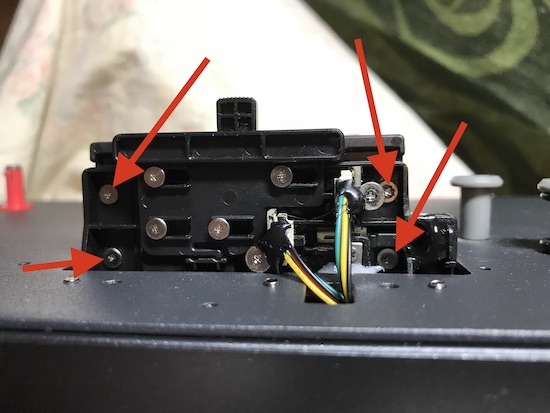
Fortunately, unscrewing these screws doesnít necessiate the removal of the entire mechanical assembly first Ė just removing the plastic facade will be sufficient.
The film track is, unfortunately, a one-piece (meaning no width microadjustment is possible), plastic thing (with the opened gate-hatch):
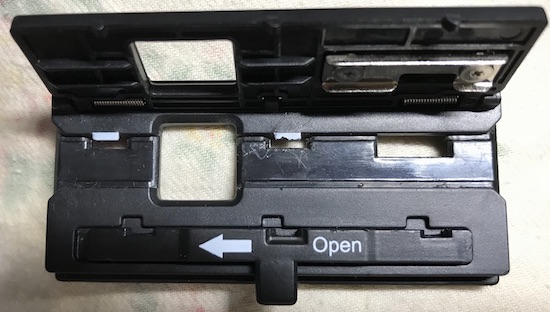
And this is from the side, this time, with a caliper showing the exact width (8.05mm) of the film track:
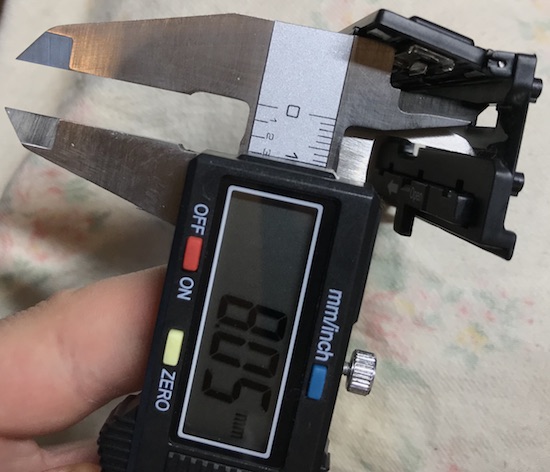
Another shot of the track, now, from the side, annotating the, in this shot, left side of the track:
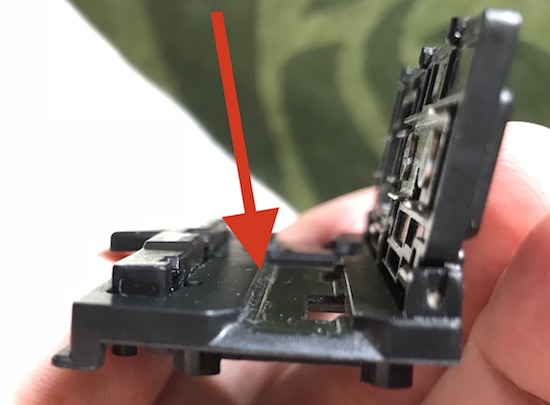
For my D8 films, the ideal width would be around 8.25mm, my filmsí (Iíve measured this too) width fluctuating between 7.8 and 8.2mm. (The depth of the track is 1.5mm and the length 6.5mm.) Iíve already mailed the Winait folks to ask whether they offer a slightly widened version of the film track to Double users. Iíll let you know when they answer.
Should Winait not offer film tracks like this, Iíll also investigate making the track widened (done by a professional with professional CNC equipment, of course). Simply spindling some 0.2mm away from the lower (in the latest shot, left) side of the track.
For the time being: if you plan to scan Double films, you may have exactly the same problem. This is invisible in many old consumer projectors. For example, I have two copies of the Soviet ďRusĒ projector and they both play the same Double-8 films just fine. The scanner only allowing for strictly 8mm (at most) movies, however, currently makes it impossible to properly scan a lot of Double footage.
Posted by Jean-Pierre Labus (Member # 6090) on December 17, 2017, 06:29 AM:
Is-it a new new version of Wolverine ?
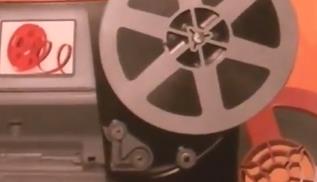
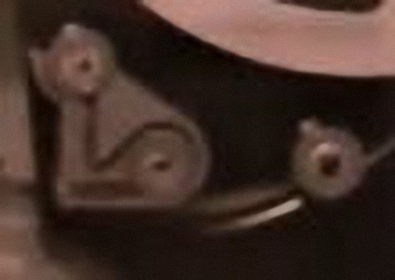
Have you any idea ?
Posted by Werner Ruotsalainen (Member # 6217) on January 09, 2018, 01:22 AM:
I'm happy to report that widening the film track did help with the Double issue I've explained about.
Note that most? all? CNC machines will NOT be able to do the trick. I've discussed this with several CNC operators and noone could widen the track. The problem was the entire plastic's being too fragile (too narrow), which would have made it prone to be simply popping out of the CNC bench during the processing, possibly also damaging the CNC itself.
Fortunately, just putting the track in a plain traditional vice and using a plain rasp did the trick. Using these tools, a friend of mine has managed to widen the track to around 8.23mm. The results are excellent: while there is no noticeable additional wobbling of films (significantly) narrower than 8.23mm (I've tested this with several Super8 and Double-8 films), almost all my problems with the Double-8 films getting stuck have been eliminated.
BTW, the Chinese folks still haven't answered my mail. That is, I don't know whether they plan to offer DIY enwidened tracks.
Posted by Werner Ruotsalainen (Member # 6217) on January 14, 2018, 12:45 PM:
Some of my exposure compensation experience you may be interested in:
Initially, I started experimenting with overriding the exposure because of the following: The general exposure is calculated using a full frame average. (As with all cheap film scanners - for example, the 14/22 Mpixel 36*24 ones.) This means it's considerably decreased when you digitize Standard 8 (not Super 8) with the sprocket holes taking up a significant area of the scanning frame. (For example, in order to digitize the possibly exposed area between the sprockets, as can also be seen in the examples below.) Then, based on how much of the sprockets are included in the frame, you'll really want to bump the exposure by, in general, 0.5EV.
To find out how the (limited) dynamic range of the scanner handles under- and overexposure, I've grabbed the same frame from a scan run of (default) 0EV (non-default) and +0.5EV. (I had to do two runs as the first run resulted in the infamous wobbling at the top. In my experimens, most second runs are already stable. If they still aren't, a third run is necessary. In most cases, two runs were sufficient for most of my films; I needed to make a third run only once.)
Turns out the scanner is certainly better at preserving highlights (or originally generally over-exposed frames) than rendering the deeper shadows. This can clearly be seen in the following four framegrabs:
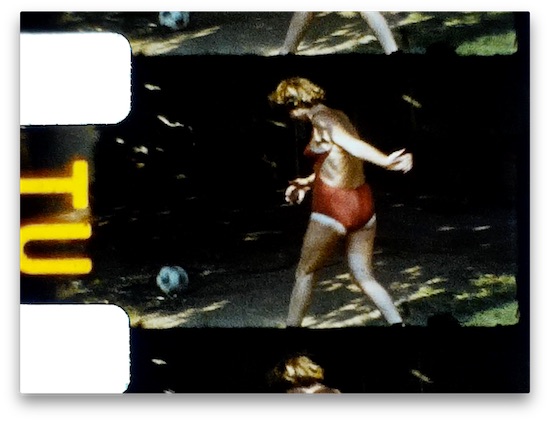
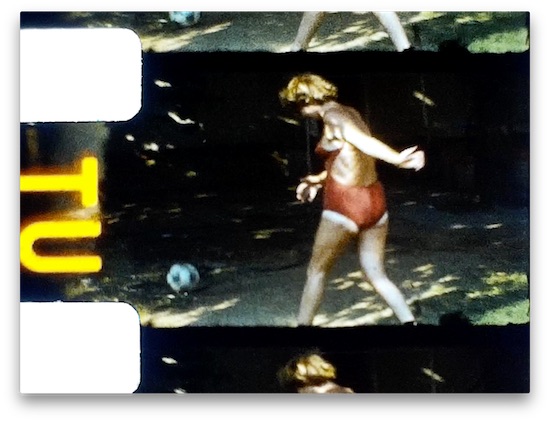
(originally under-exposed frame. As you can see, the +0.5EV shot has a LOT of additional detail simply not present in the 0EV one.)

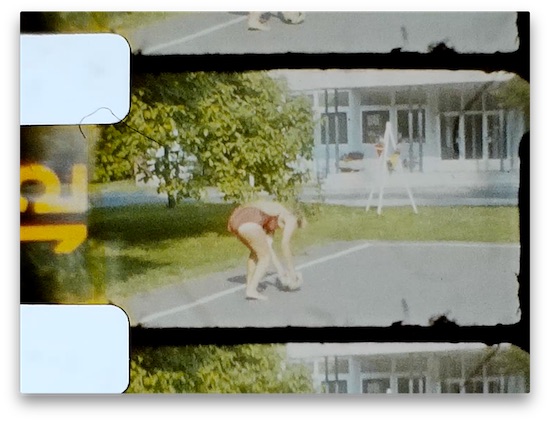
(originally over-exposed frame. As you can see, the +0.5EV shot doesn't really have burnt-out detail compared to the 0EV one.)
(All this with ORWO UT-15 footage. Interestingly, this - back in the 80's - significantly cheaper material has turned out to keep its colors sigificnatly(!) better than the other and about two times more expensive material, AgfaChrome, I used for Super-8 shooting back in time. The latter has lost its green components almost entirely in 33+ years. I've kept the films in exactly the same place. ORWO wasn't that bad a material, after all...)
All in all, in general, to make good use of the DR of the scanner, you may want to prefer a slightly positive exposure compensation, particularly if you have some originally under-exposed shots in the roll and don't want to digitize those separately. (The latter is certainly my case - I don't have the time to scan every - short - shot separately. I prefer generic, global settings.)
Posted by Peter Malling (Member # 6233) on January 15, 2018, 04:30 PM:
What is the status now everybody who bought the Somikon scanner? Would you recommend to buy it for super 8 scanning?
Posted by Werner Ruotsalainen (Member # 6217) on January 15, 2018, 06:16 PM:
"What is the status now everybody who bought the Somikon scanner? Would you recommend to buy it for super 8 scanning?"
IMHO, it's great for the price. I'm very happy with it. Have scanned some 100 standard 8 and 10 Super 8 rolls so far.
And if you encounter the "wobbling" problem (I do in 20-30% of the cases), just re-scan the given roll. It'll help.
Posted by Peter Malling (Member # 6233) on January 16, 2018, 05:55 AM:
Thanks Werner! Maybe I'll go for it then.
Posted by Berend De Meyer (Member # 5856) on January 19, 2018, 04:11 PM:
Sorry for my neglect of this topic people! Been very busy with erverything besides my 8mmToDigital project. For instance building my new Ubiquiti UniFi home-network and VideoHi8 converting projects.
My 3rd Somikon is still boxed, so I hope I'll find sone time soon to carry out some new testing!
Good luck to all (new) Somikon users.
Cheers
Posted by Werner Ruotsalainen (Member # 6217) on January 20, 2018, 05:35 PM:
Folks, I've posted a quick tutorial on changing the framerate of the video on page 12 of the Wolverine topic:
http://8mmforum.film-tech.com/cgi-bin/ubb/ultimatebb.cgi?ubb=get_topic;f=1;t=011395;p=12
Posted by Werner Ruotsalainen (Member # 6217) on January 28, 2018, 05:53 AM:
This may help with the wobbling problem: I've exhibited it quite frequently lately, but mostly with Super8 films. (The vast majority of my Std8 scans have been OK. I also found out that respool the entire film reel at least once before the scan reduced the around 20-30% wobbling percentage to almost zero. Again, this is Std8 only; with Super8, this doesn't really help.)
I've played with putting clothes pegs (clothes-pins) to force down the film to the gate. At first, I've tested this setup:
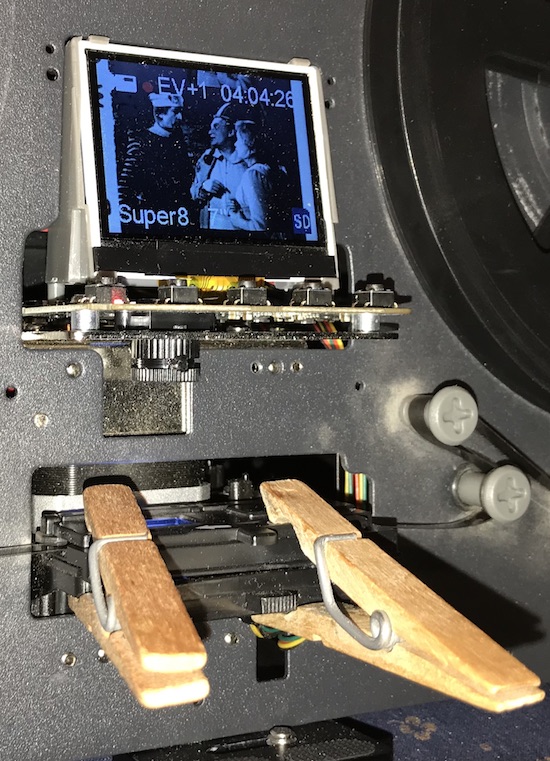
(Of course, you'll need to remove the plastic facade first to gain full access to the bottom plate of the gate. It's easy.)
With this mod, the results became pretty OK: https://www.youtube.com/watch?v=3ocj8MprCq4
NOTE:
1. the first 10-20 seconds have been taken without the clips applied. This is why they are super-wobbly there.
2. this is the East-German DEFA Super8 mm version of Rumpelstiltskin. The full documentation of what's happening in this film version (in German) is at https://www.flickr.com/photos/33448355@N07/39034875115/in/album-72157692569177485/ (see the right page; the left one is just a generic overview of the then-available DEFA films) and https://www.flickr.com/photos/33448355@N07/39034873185/in/album-72157692569177485/
Then, for the second half of the scan, I've removed the right clip, only keeping the left one. This has further helped, which could also be heard right away. (The clicks became much louder and more defined - almost as loud as with Std8 films.) The footage is here (the first seconds wobble as I still played with the clips then.): https://www.youtube.com/watch?v=YYI-BXx3MDw
This trick may also help you if you encounter the same wobbling.
Posted by Berend De Meyer (Member # 5856) on January 28, 2018, 06:37 AM:
Hi Werner!
Thank you so much for your veey detailed workaround!
Cheers, Berend
Posted by Werner Ruotsalainen (Member # 6217) on February 03, 2018, 09:40 AM:
And still modtime...
1, I've found out that, over time, the upper spring-loaded gate becomes so weak that the take-up wheel has a really destructive effect on the scanning, resulting in a lot of wobbling. My solution is simple: I just block the take-up wheel with a pen and let the film fall on the floor. From time to time, I remove the pen so that I can spool the film on the wheel:
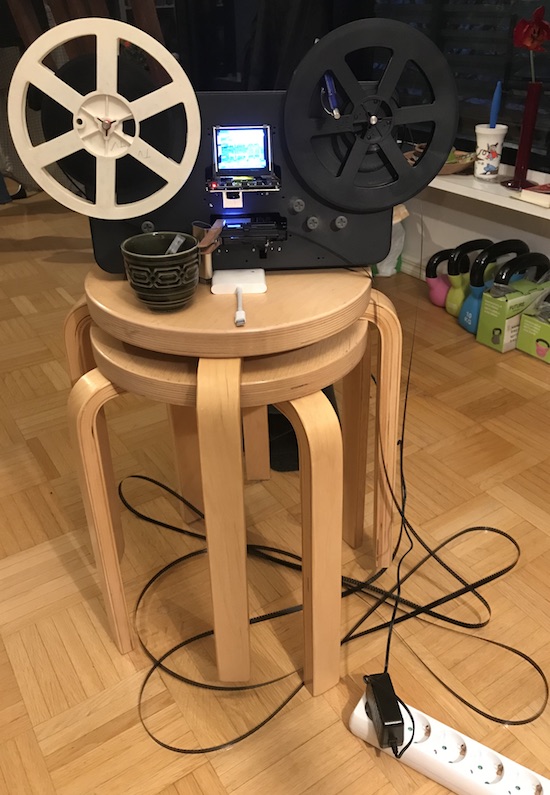
The image also shows a clip on the left side of the gate and also a slight push on the film backwards where it enters the gate to further minimize horizontal "dancing".
2. WRT the Standard-8 (double-8) problem I explained above: turns out (see the review starting with "Beware that you may need to "modify" the track" at https://www.bhphotovideo.com/c/product/1371442-REG/wolverine_data_f2dmmpro_moviemaker_pro_8mm_and_super_8.html ) others have had exactly the same problem, and the manufacturer even told them to use a knife to widen the track. Or, to send the entire(!) machine and a "sticky" film back to them so that they widen the track (for a fee).
(Now I wonder why the manufacturer didn't bother answering my mail, which I sent them some 6 weeks ago, asking for (not for free!) an already-modded gate...)
Posted by Mike Spice (Member # 5957) on February 03, 2018, 04:18 PM:
are you not concerned that blocking the take up reel in this manner will put a great strain on the take up motor?
Would it not be possible to mount the take up reel on an independent assembly of some kind instead of on the scanner, if you choose to take up film this way?
just a thought.....
Posted by Werner Ruotsalainen (Member # 6217) on February 04, 2018, 02:01 AM:
Yup - I'm thinking of soldering in an on/off switch to easily start/stop the take-up reel. Otherwise, when I can't block the movement any more (the reel has a lot of film so I can't insert a pen in there any more), I just take it off and only put back when I'm around and can spool the film.
BTW, so far, elminating the take up wheel's effect has worked great. About half of my S8 reels exhibit absolutely no wobbling right at the first scan; the other half in the second. Just an example of a scan done this way:
https://www.youtube.com/watch?v=RyzXn1N6o_k
(East-Romania, 1981?; S8 Kodachrome; 12:30 minutes. Directly the scanner's output - no stabilization, no nothing, with as much overscan as possible (w=0).)
https://www.youtube.com/watch?v=mzicVCuHR7Y
(Czehoslovakia + Germany + France, 1975; 16:51; S8 Kodachrome. See the video description for some of the sights.)
[ February 04, 2018, 07:10 AM: Message edited by: Werner Ruotsalainen ]
Posted by Werner Ruotsalainen (Member # 6217) on March 24, 2018, 12:22 PM:
Folks, I don't know whether this is only a Somikon-branded bug or also affects the Wolverine / Reflecta-branded ones as well: the "Sharpness" setting is fully disregarded at least in the latest (Oct/17, 2017; the one with the 20 fps) firmware. Please see my today's post in the Wolverine thread:
http://8mmforum.film-tech.com/cgi-bin/ubb/ultimatebb.cgi?ubb=get_topic;f=1;t=011395;p=13
Posted by Georg Muller (Member # 6088) on April 01, 2018, 08:30 AM:
Dear All,
I have 22 reels of 5" sound super8 movie to digitize. I made a test with a digitizing lab and got very bad results. I consider buying a Somikon-Wolverine-Reflecta-Winait device.
Could someone give me an answer on the following questions:
1) could the magnetic strips of the sound super8 film be damaged during the process of digitizing or is it safe?
2) My Eumig sound projector has a headphone outlet but when I listen I just get sound in the left ear, the right track is used for additional sounds like music but I never made use of it. My idea is to copy the first sound track on my computer. Can it be done just by connecting the headphone outlet of my projector to the mike inlet of my computer through a cable or do I need a special intermediate device? What do I have to do to get my mono track on the two loudspeakers of my computer.
3) I then have to synchronize sound track and movie. It won't be easy. Does a software exist?
Best regards.
Georg
Posted by Ken Abruzzo (Member # 6188) on April 01, 2018, 01:28 PM:
Hi Georg,
I can't really answer your first question. I don't THINK it would hurt it, but I really don't know for sure.
I think you should be able to hook up the output of the Eumig to your computer's input. If there's only one, it's probably a split input that can be used for either mic or line in. It would either detect this on it's own, or your sound driver control panel would let you select mic/line in. You'd want to use line in. Is the output on the Eumig stereo or mono? You could either make a cable to get the single channel onto both channels of the computer....... or do it in software. Record the output to a single channel and then use a wave editor such as Audacity to mirror the track onto the second channel. It's a free download. You might have to fiddle with recording levels until you get something you like. Give it a shot. At worst, it doesn't work.
Synchronizing, I have no idea what's out there to do that. None of my footage had sound. I just drop music files in to give it a sound track. I'm using Powerdirector 16. I can't remember if there's a sync option in there since I never had a need for it.
Posted by Georg Muller (Member # 6088) on April 02, 2018, 04:32 AM:
Dear Mr Abruzzo,
thank you for your help.
By looking closer to my projector and to its spec, I found a line output in the form apparently of a 5 pin DIN male plug designed to connect the projector to an amplifier. I found on internet a lead made of a 5 pin DIN plug to a 3.5 mm jack stereo audio. May I connect directly this lead to the mike inlet, also a 3.5 mm jack female, of my computer?
In the projector spec, it is written that they use the pins 2 and 3 only, I guess it means no stereo.
Best regards.
Georg
Posted by Mike Spice (Member # 5957) on April 02, 2018, 06:01 AM:
I use Audacity (free) software to record the audio and export that as a wav file.
Then I use video edit software to import the film scan and the audio file and then spend ages lining the two up to be in sync.
It's not easy because you will have the scan of the film as the wrong speed, the audio at the right speed, assuming the projector speed is stable) and a video edit software trying to run at 24/25fps
It is possible, I have managed some short examples.
It is fine to connect the headphone of a projector to the line in of a pc or laptop, just begin the the volume at around 1/3 while you set audacity recording and watch the record levels, increase the projector volume gently to get a good signal.
Set audacity to record in mono in it's preferences, record the audio, as it will be mono, you will need to then copy and paste the recorded audio to a new track, in an indentical position under the original recording.
To the left of the audacity tracks, there is a pan control, pan one track left, one track right, and 'export' the audio.
The reason for copying audio to a new track is becuase if you don't you will only get audio from one speaker on your pc or laptop.
Or you could use video edit software to make the audio appear on both left and right channels.
I use san serif movieplus X6 for my simple edits.
Its possible windows movie maker could do the job, but it won't be easy lining up the audio to picture in WMM as it is such a basic program with little chance of adjusting speed variations in your content.
audio recorded in mono
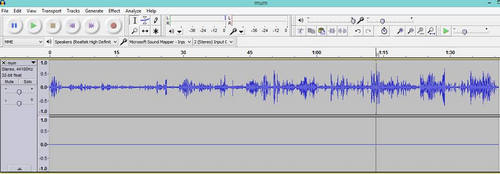
audio copied and pasted to a new track
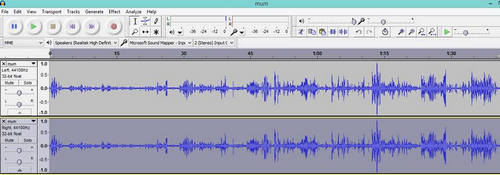
Lining up audio and picture in video edit

sound example, not quite perfect, You Tube Video.
[ April 02, 2018, 04:13 PM: Message edited by: Mike Spice ]
Posted by Georg Muller (Member # 6088) on April 02, 2018, 07:19 AM:
Dear Mike,
thank you for your quick answer.
On another topic named "Record soundtrack ..." Berend De Meyer explained that he used the line output of his projector. Since I have one on mine (5 pin DIN) may I directly connect this output to the mike 3.5 mm jack input of my pc?
BTW is it worthwhile to spend so much money(scanner) and effort(me) to digitize my movies by DIY rather then letting the job made by a lab?
I have a very bad experience with my 6 first reels?
They were digitized with the help of a camera aiming at a projector through a special lens.
Best regards.
Georg
Posted by Mike Spice (Member # 5957) on April 02, 2018, 09:18 AM:
without doubt it is a lengthy time consuming process.
to scan 200ft of film takes around 2 hours
the sound recording process is pretty straight forward if you understand audio software.
You could by all means use the DIN output to the 3.5mm line in of the laptop, but I would consider there no difference in audio quality to the headphone socket. In my real life I connect with headphone sockets to large PA systems with ease.
The only point to note, you say the 'mic' input, this is only designed for microphone level signals so a line input from either a DIN or headphone socket will distort considerably.
Some pc's have the ability to be mic and line level in software, you may have to look in to that. My laptop is set to the line in level
A mic input is not suitable for a projector output
If you have a number of sound reels, it might be better to pay a different lab to do the job for you if you have misgivings about recording and syncing your own material.
You would probably need to spend some money on a basic video software too, mine is discontinued now, but it only cost me $30
I don't feel the need to purchase sony vegas or final cut for my little efforts.
good luck, sorry i wouldn't know which lab to suggest for having sound movies transferred.
The hardest part of the process is syncing up the audio to picture, as I mentioned earlier, a 30fps film scan, audio from a projector, which may or may not be perfectly stable in it's speed, and the task of syncing is not for the faint hearted in terms of frustration......
Getting proper 'lip sync' is a tough call if like me, your projector speeds are a bit off during the audio record......
[ April 03, 2018, 09:23 AM: Message edited by: Mike Spice ]
Posted by Berend De Meyer (Member # 5856) on April 03, 2018, 09:15 AM:
Hi Georg (all),
If this 8mm sound project your aiming at will be worth the money and effort is of course up to you. Scanning the 8mm with the Somikon is rather straight forward, except for adjusting the frame rate. Recording the sound and syncing it will be your biggest quest - at least it is for me - and challenge. I had some recordings on one reel taken with 18 and 24 fps in-camera, so had a lot of switching to do.
My experience is that - although silent 8mm is already a very time consuming task - getting the soundtracks recorded and synced is even a greater one.
I see that Mike has given you some great advise and workflow to try. Good luck with yours.
Posted by Dino Motti (Member # 6415) on April 05, 2018, 04:07 AM:
I own a somikon XL. I am struggling to understand why the compression artefacts are so severe.
I read here and on the wolverine thread that some believe it is a MP4 compression issue, some instead a JPG compression problem of the single frames.
I also read that extracting the card from the machine, before the video file is saved, will preserve the single frames of the scan and allow me to process them on a computer. Is this true?
If somebody tried that approach do we know if the problem is with the JPG or MP4 compression?
Has anyone contacted the hardware producers to see if we can improve the quality of the compression of the frames/video? I would be happy to sacrifice speed if that helped to reduce the artefacts that are so severe sometimes faces are unrecognisable in some videos...
Thank you for the effort you have been making here to improve the firmware and get to the bottom of the issues with the wolverine and the somikon.
Posted by Werner Ruotsalainen (Member # 6217) on April 08, 2018, 03:56 AM:
Welcome Dino Motti,
1, I've tried removing the card while in use. No sign of individual JPG images.
2, you will need to scan in "Low" sharpness mode to minimize compression artefacts. Note that it may NOT produce different images from that of the default Normal mode. (See my earlier post on this.) Then, you'll need to install the hacked Wolverine FW, which does indeed enable it (and has no "forgetting sharpness setting during power cycles" bugs).
Posted by Berend De Meyer (Member # 5856) on April 08, 2018, 07:17 AM:
Hi all!
Today I unboxed the replacement Somikon I received in September 2017. It is shipped with FirmWare - 20170421-PL07-DE - so it's an update to my older Somikon's which held PL05. Of course I'm curious what changes were made here.
Testing artifacts - photo's taken from my HP Monitor (using the TV-Out on the Somikon and component Video-In on my monitor) with iPhone - using only the Exposure Settings (-2, -1, 0, 1, 2) resulting in worst to best:
EV-2
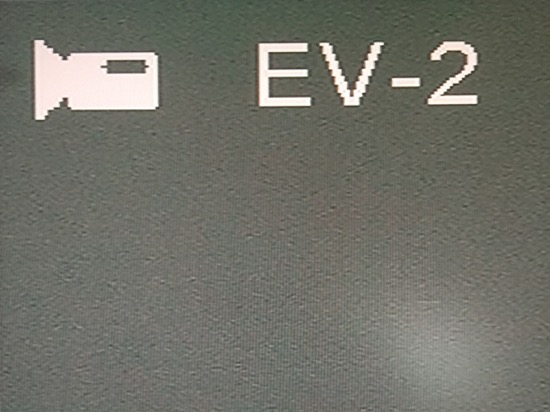
EV-1
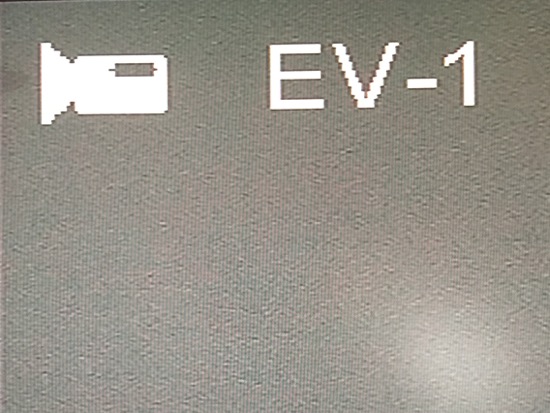
EV-0
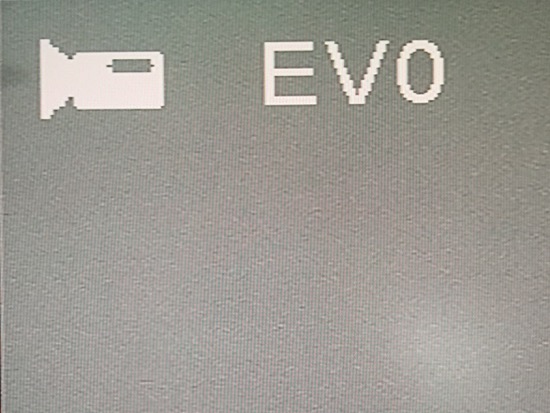
EV+1

EV+2
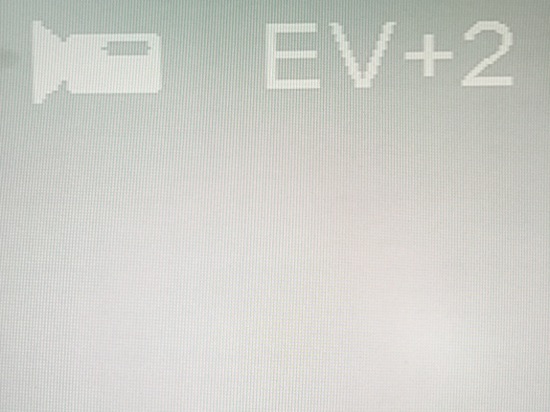
Will do some more tests today with actual footage and keep you posted on the results.
EDIT [16:31] Done some testing with the exposure during a capture without film, so just the plain sensor only:
https://youtu.be/BKzIzcnspJs
I noticed a horrible colorcast for the settings EV-1 and EV-2.
[ April 08, 2018, 09:33 AM: Message edited by: Berend De Meyer ]
Posted by Berend De Meyer (Member # 5856) on April 09, 2018, 01:29 PM:
For those who want some post-scanning color grading (white balanced) and cleaning the video output here an example I made with my latest Somikon HD-XL.
Somikon HD-XL -> Final Cup Pro X + Neat Video Plugin
1. FCPX:
- Change FPS to 18 (original camera speed)
- White Balance
- Transform -> changing anchor point (center) to hide the bad top and bottom; you lose some of the viewing
- Crop -> Top and Bottom black strokes to hide the bad upper- and lower of the frames
2. Neat Video Plugin
South Africa 1976 - Home Video
RAW

EDITED

I'm quite happy with the results.
Posted by Werner Ruotsalainen (Member # 6217) on April 14, 2018, 04:24 PM:
quote:
https://youtu.be/BKzIzcnspJs
I noticed a horrible colorcast for the settings EV-1 and EV-2.
Speaking of color casts, let me publish my experience on the aging of different color film stock. You may know the symptomps of the badly-aged stock: absolutely awful bluish cast everywhere.
Kodachrome films age wonderfully. I've scanned a lot of Kodachrome II / Kodachrome IIA / Kodachrome KM etc. material; all exhibit an excellent color balance even after these years. The (currently) oldest material I have is a scan of Kodachrome II Std8 films from 1964 (the German army stuff at https://www.youtube.com/playlist?list=PL4_1cuziVtq-xA4BzygOWwI7cjPv9n4U0 ).
So do very(!) old AGFA(German) material, including even late (produced in the 80's) ORWO (East-German) stock based on the very old AGFA technology. My earliest color AGFA scans are from 1955 and exhibit no color problems. (These color films have been already manufactured in East-Germany but with the original AGFA tech.) See for example https://www.youtube.com/watch?v=v84Wd0lMU44&list=PL4_1cuziVtq-5b38a1xM8NaHSV jZ1ipv4&index=2&t=1000 or https://www.youtube.com/watch?v=ID9aRrAOrdY&index=12&list=PL4_1cuziVtq-5b38a 1xM8NaHSVjZ1ipv4&t=600 . BTW, the entirely color film collection at https://www.youtube.com/watch?v=Tb2xad5Ezi4&index=14&list=PL4_1cuziVtq-5b38a1xM8Na HSVjZ1ipv4 also show the same stock a bit overexposed (this is why I used -0.5EV during capture) during the entire run if you want to know how it behaved in case of a typical user error.
Note that, if you compare the resolution of these color films to the b/w ones in the same 1955 album ( https://www.youtube.com/playlist?list=PL4_1cuziVtq-5b38a1xM8NaHSVjZ1ipv4 ), you can easily see b/w films had definitely better resolution than these early color films.
An example of East-German (starting with the sixties, ORWO-branded) but, color keeping-wise, equally good footage from the eighties: (ORWO UT15): https://youtu.be/6f8UCBNOXoU (60p processed) / https://youtu.be/sikYV0EdGms (16p original)
And now, Kodak Ektachrome. The second and third Ektachrome 100 Super8 cartridges in the three-cartridge film shot in Riga in the Soviet Union in 1980 ( https://youtu.be/ggikR8kFU74 (60p); no 18p version available) have been made with exactly the same camera, at the same location, same time and (obviously) kept in the same environment (heat etc.) as the first one, which is a Kodachrome KM. The difference speaks for itself Ė the Kodachrome KM footage is wonderful, unlike the Ektachrome 100. This also means curretly available, raw Ektachrome stock may age equally badly if you use them for shooting now...
(Iíll later post late (70/80ís) Agfa footage too. Generally, it, color-wise, sucks compared to Kodachrome or even to ORWO.)
[ April 15, 2018, 12:19 AM: Message edited by: Werner Ruotsalainen ]
Posted by Berend De Meyer (Member # 5856) on April 16, 2018, 06:54 AM:
Werner Thank you so much for all your additional info's and footage shared. Much appreciated!
In the box of my latest shipment of the Somikon HD-XL I received a small plastic bag with three O-rings in it. As per the manual this is apparently to guide the film on the first glider on the right side of the scanner. One on each side of the film.
Three O-rings
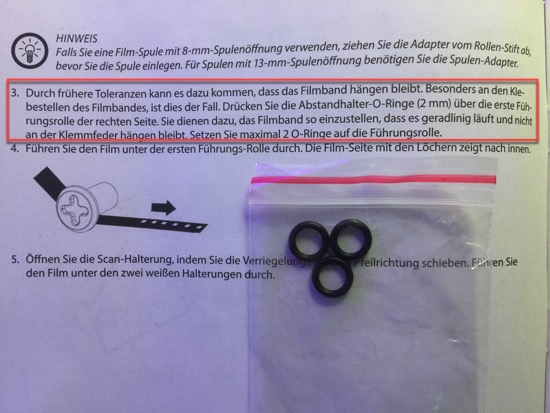

I haven't used them so far, perhaps this is a possible solution for the Jumping Jack Flash symtoms of our scanners? Do the Wolverine/Reflecta ship with the same three O-rings?
I'll test them this week, keep you posted...
Posted by Berend De Meyer (Member # 5856) on April 17, 2018, 02:09 PM:
It seems to me that Neat Video and Optical Flow don't play together very well, because it leaves more noticeable noise and dust / scratches behind than without the Optical Flow.
Posted by Werner Ruotsalainen (Member # 6217) on April 19, 2018, 03:09 PM:
quote:
It seems to me that Neat Video and Optical Flow don't play together very well, because it leaves more noticeable noise and dust / scratches behind than without the Optical Flow.
You need to run Neat Video BEFORE any in-FCPX framerate change. This also means you'll want to feed the originals to FCPX already in 24, 30 or any standard framerate - and definitely not 20. Then, no additional frames will be added.
After running Neat Video, reimport the now-cleaned footage and, now, you can increase the framerate to for example 60p to make the movement more fluid. Now, albeit the dirt etc. will also "spread over" several frames, the overall effect will still be much better than doing the opposite (running Neat Video on already-Visual Flow'ed footage).
Posted by Berend De Meyer (Member # 5856) on April 20, 2018, 06:39 AM:
Werner Thank you for your explanation! Will test it...
Posted by Werner Ruotsalainen (Member # 6217) on April 20, 2018, 10:35 AM:
BTW, back to the matter of the differences in the aging of different film material. Above, I've explained Kodachrome, very old Agfa and OR-WO age without problems, unlike newer Agfa (at least the stock manufactured starting in the '70s) and some other brands.
I now also have first-person experience with Fujifilm Safety Film with the edge codes '7 59' very close to 'Fujifilm Safety Film' and, separately and much farther away, '23'.
These definitely arenít Fujiís own date codes (see http://www.brianpritchard.com/Date%20Codes.htm ) - after all, in 1959 (assuming Ď59í stands for 1959), Super8 didnít even exist. Also note that Fujiís film list at http://www.fujifilm.com/products/motion_picture/discontinued/pdf/fujifilm_motion_picture_film_manual.pdf doesnít even list 8mm material, only 16 and 35.
The colors are OK and there's no really significant color shift in the appr. 41...43-year-old films (showing the German town Bremen) I've scanned and uploaded to YouTube: https://youtu.be/prn324LBI8w (original, overscanned 18p) / https://youtu.be/DTPkF5c9oto (Motion Flow-processed 60p).
Posted by Werner Ruotsalainen (Member # 6217) on May 04, 2018, 05:25 PM:
I've purchased a 7" 16mm film spool off Finnish eBay. It's mostly shot on Kodachrome in 1942 (and probably also 1-2 years before). The film is in excellent condition: it isn't brittle and there's no sign of the VS. The film was surely kept in a (comparatively) cool environment. (Which isn't very hard here in Finland, LOL ![[Smile]](smile.gif) )
)
I, not having a 16mm scanner, still haven't got it in a scanned format. I've, however, made some still scans of all the scenes in the film; with scenes depicting not only family life, more frequently. These scans also show how the colors have survived during all those 76-77 years.
A very small section of the spool is shot on b/w (Kodak) film. As usual with films of that age (also see my 1955-1956 East-German film scans), it exhibits far better resolution than the color footage.
I've, in addition to the auto-named image files, also added some filename postfixes for new and interesting scenes; for example, "3-PICT0033 - Helsinki from ship STARTS HERE" ( here ) on page 2 ( here ) etc.
The first page of the album is at here . Note that the first around 120 images are strictly (not particularly interesting) family images; sights only start later.
Also note that, while it was shot during WW2, there isn't anything related to the ongoing war anywhere - it was shot way away from the front lines.
Posted by Dino Motti (Member # 6415) on May 08, 2018, 07:14 AM:
Just FIY, on the wolverine thread we are exploring ways to extract the JPG and raw video files before they are compressed into MP4 to reduce the artefacts.
Everyone's contribution to crack this is welcome. :-)
http://8mmforum.film-tech.com/cgi-bin/ubb/ultimatebb.cgi?ubb=get_topic;f=1;t=011395
Posted by Dimi Velikov (Member # 6593) on August 29, 2018, 04:05 AM:
Hi all,
I have a question for Berend De Meyer (however if anyone else can help me , i would be thankful) - he posted photos with ventilation holes on the back of the device (im reposting photo below).
I was thinking of buying the device from Amazon.de from PEARL.DE seller , but when i asked seller a question if device comes with vent holes (as his listing was showing back plate without vent), and got an answer :
"We currently do not sell another version of this device. Nor have
we any information about an updated version from the manufacturer.
Mit freundlichen GrŁŖen
Anthony Jenkins"
Now my quesiton is - where have you bought the device with ventilation, as i have lots of films to scan and from the forum i understood that overheating is one of the engineering bugs to concern, so would like to buy an updated version.
Would be very thankful for your help
Dimi
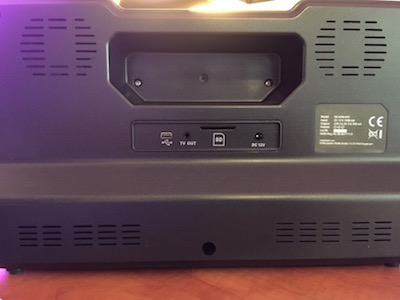
Posted by Dino Motti (Member # 6415) on September 05, 2018, 04:22 AM:
I bought the ventilated Somikon from Pearl.de
Trying still to reduce the noise/compression artefacts.
Anyone had any luck with settings? or exporting the single frames?
Posted by Dan Esmond (Member # 3975) on September 05, 2018, 04:27 PM:
Dino did you try the Neat video plugin? Berend De Meyer posted about it above. It looks like it really does a good job of "hiding" the artifacts.
Being a purist, that's still not a true solution to me (because those artifacts permanently reduce resolution and fine detail that would otherwise be captured), but I think we have to live with it for now. There's nothing else on the market (that's affordable for home users, anyway) that will do frame-by-frame captures of regular 8mm, so I've had to bite my tongue and be happy that at least I'm able to share memories from long ago with family and friends far and wide. The movies from the Wolverine look perfectly fine to most people. It's just we unfortunate souls with high expectations that can't help but see the flaws.
The technology exists today to scan 8mm/Super-8 in 5K res, in HDR to get detailed shadows and highlights, with optical frame stabilization to align all the frames, in a codec that captures enough detail in the chroma to do good color correction. It's just not available in home devices yet. The Wolverine/Somikon get us some distance toward that goal (just having frame-by-frame is a vast improvement over older telecine methods), but there's a long way to go to get truly archive-worthy captures.
I hope that technology becomes affordable eventually, because I will absolutely scan all my reels again to get all the quality present in those frames. Meanwhile, my family and I are enjoying walking down memory lane and looking at films that hadn't been seen for 30-40 years.
Went off on a tangent there but do check out the Neat plugin... Berend's results from it were pretty impressive from what I saw. https://www.neatvideo.com
Posted by Winbert Hutahaean (Member # 58) on September 05, 2018, 06:47 PM:
quote:
I've scanned and uploaded to YouTube: https://youtu.be/prn324LBI8w (original, overscanned 18p) / https://youtu.be/DTPkF5c9oto (Motion Flow-processed 60p).
Hi Wegner, I am sorry for my ignorance, but what does 18p vs 60p mean? and which one produces better image?
thanks,
Posted by Nantawat Kittiwarakul (Member # 6050) on September 05, 2018, 09:02 PM:
quote:
Hi Wegner, I am sorry for my ignorance, but what does 18p vs 60p mean? and which one produces better image?
Simply put,
18p = the original filming speed,thus the exact 1:1 film scan.
60p = the original 18fps "interpolated" to 60/59.94 fps,to smooth out the jerkiness in the original footage due to the low framerate.
![[Smile]](smile.gif)
Posted by Winbert Hutahaean (Member # 58) on September 05, 2018, 11:24 PM:
Thanks Nantawat, but at the 18p on the youtube link above, my eyes can see the speed is faster. I feel it is not like my home movies played on my projector at 18 fps.
You can check on 0:26-0:31. The body's move of the gentleman with blue shirt and tie is not natural to me. Is it my eyes or it is actually not 18 fps as in projector?
Posted by Julian Mildren (Member # 3247) on January 25, 2019, 08:38 AM:
Just unpacked my Somikon - not using the mounts for the film - using the free reel and bin on the floor method - and outputting to a decent 9" Sony Pro monitor form the 80's - all very nice - done over 5000' in the last few days - BUT, does anyone know how to set the date and time on this?
I have to add, for the price - it's excellent!
Posted by Thomas Berger (Member # 6896) on March 12, 2019, 12:19 PM:
I will start to digitized with the Somikon and I'd like to summarize all hints in this thread.
- Put the the somikon in a 30į angle
- Put a clamps on the left side of the film gate
- Stop the right wheel and let the film fall in a bin or box
- Use the current 20p firmware and try to recover deleted original jpg from the sd card
- OR use the hacked wolverine firmware on the somikon for direct HD
- Use Neat Video v4 to reduce the noise
- Use FC or Film9 or similar tools to get from 20p to 50p
Did I miss something or is there anything wrong from this list?
[ March 12, 2019, 01:39 PM: Message edited by: Thomas Berger ]
Posted by Werner Ruotsalainen (Member # 6217) on March 12, 2019, 05:30 PM:
quote:
Use FC or Film9 or similar tools to get from 20p to 50p
You mean artifically increasing the framerwate with motion prediction? It can look pretty unnatural. I used to do it but lately stayed with the original 16/18p.
Posted by Thomas Berger (Member # 6896) on March 13, 2019, 03:11 AM:
Thanks Werner for your reply.
This means you stick with your recommendation from the last post of this thread but without transforming to 50p
http://8mmforum.film-tech.com/cgi-bin/ubb/ultimatebb.cgi?ubb=get_topic;f=1;reply_num=000006;t=011636
This means for me the other things are good in your opinion?
Do you have opinion about Film9 vs Neat Video v4?
Visit www.film-tech.com for free equipment manual downloads. Copyright 2003-2019 Film-Tech Cinema Systems LLC

UBB.classicTM
6.3.1.2
![[Cool]](cool.gif)
![[Cool]](cool.gif)
![[Cool]](cool.gif)
![[Cool]](cool.gif)

![[Cool]](cool.gif)



![[Cool]](cool.gif)
![[Cool]](cool.gif)
![[Big Grin]](biggrin.gif)




![[Wink]](wink.gif)
![[Confused]](confused.gif)




















![[Smile]](smile.gif) )
)
![[Smile]](smile.gif)